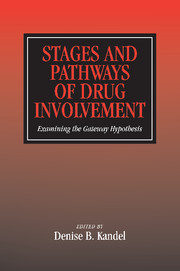Book contents
- Frontmatter
- Contents
- List of Contributors
- Foreword
- Preface
- Part I Overview
- Part II Recent Substantive Findings: What Do We Know About Stages of Drug Use, Risks, and Protective Factors?
- Part III Impact of Prevention Interventions: A Test of the Progression Hypothesis
- Part IV Methodological Issues and Approaches: Advantages and Limitations of Alternate Methods
- Part V Animal Models and Biological Processes: Implications for Drug Progression
- 13 The Value of Animal Models to Examine the Gateway Hypothesis
- 14 Sensitization as a Process Underlying the Progression of Drug Use via Gateway Drugs
- 15 Neurobiology of Drug Addiction
- Part VI Conclusion
- Index
13 - The Value of Animal Models to Examine the Gateway Hypothesis
Published online by Cambridge University Press: 25 July 2009
- Frontmatter
- Contents
- List of Contributors
- Foreword
- Preface
- Part I Overview
- Part II Recent Substantive Findings: What Do We Know About Stages of Drug Use, Risks, and Protective Factors?
- Part III Impact of Prevention Interventions: A Test of the Progression Hypothesis
- Part IV Methodological Issues and Approaches: Advantages and Limitations of Alternate Methods
- Part V Animal Models and Biological Processes: Implications for Drug Progression
- 13 The Value of Animal Models to Examine the Gateway Hypothesis
- 14 Sensitization as a Process Underlying the Progression of Drug Use via Gateway Drugs
- 15 Neurobiology of Drug Addiction
- Part VI Conclusion
- Index
Summary
Despite extensive correlational data and discussion of the Gateway Hypothesis, there is little direct empirical evidence that addresses its potential causal mechanisms. The possible causes for initial drug use and subsequent transition from use of one drug to use and abuse of other drugs include psychological, sociological, economic, behavioral, and biological variables. It is difficult, if not impossible, directly to examine and manipulate any of these possible explanations in children. The existing literature on reasons for drug use initiation and maintenance in children is restricted to self-reports. In contrast, the literature on adult drug initiation and maintenance includes self-reports as well as experimental examination of behavioral and biological effects of drugs. Importantly, continued drug use in adults, as self-reported and as indicated in experiments, largely results from the behavioral and biological effects of the self-administered substance. Self-report studies in children also suggest that young people use drugs because of their behavioral and biological effects. It is possible that these drug effects in young people are part of the causal mechanism of the Gateway Hypothesis.
Animal models have contributed substantially to the study of drugs of abuse and allow testing of causal hypotheses regarding drug effects. Although most of these studies have examined drug effects in adult animals, the paradigms and methods are readily applicable to younger animals. Animal models to evaluate human drug use are only valuable if they parallel and predict the human condition.
- Type
- Chapter
- Information
- Stages and Pathways of Drug InvolvementExamining the Gateway Hypothesis, pp. 289 - 317Publisher: Cambridge University PressPrint publication year: 2002
- 3
- Cited by



